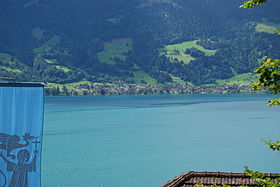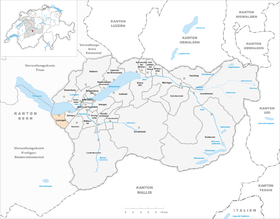Leissigen
| Leissigen | |
|---|---|
| State : |
|
| Canton : |
|
| Administrative district : | Interlaken-Oberhasli |
| BFS no. : | 0585 |
| Postal code : | 3706 |
| Coordinates : | 625594 / 167139 |
| Height : | 575 m above sea level M. |
| Height range : | 556–2248 m above sea level M. |
| Area : | 10.38 km² |
| Residents: | 1123 (December 31, 2018) |
| Population density : | 88 inhabitants per km² |
| Mayor : | Erika Jost |
| Website: | www.leissigen.ch |
|
Leissigen seen from the entrance of the Beatus Cave |
|
| Location of the municipality | |
Leissigen is a municipality in the Interlaken-Oberhasli administrative district in the canton of Bern in Switzerland .
Erika Jost has been the mayor of the Leissigen community since August 1, 2019. In addition to the resident community, there is a civic community with the same name. The Evangelical Reformed parish is run together with Därligen .
Place name
The name Leissigen comes from the Old High German personal name Lantgis and the place name ending -ingun and means "for the people of Langtis / Langis".
geography
Leissigen is located in the Bernese Oberland on Lake Thun . The neighboring communities starting from the east in a clockwise direction are Därligen , Saxeten , Aeschi bei Spiez and Krattigen . The Morgenberghorn (2249 m above sea level) forms the southern boundary of the municipality .
economy
Tourism in Leissigen is very old. As early as 1628, the Interlaken monastery had a monastery tavern in Leissigen. As a result, the spa and bathing industry took off. A Leissig bath was first mentioned in 1733 .
In 1870 a steamship docked in Leissigen for the first time. With the construction of the Thunerseebahn in 1893, tourism really got going. The Leissigen Tourist Office was founded as early as 1901.
The Meielisalp with the Hotel Meielisalp restaurant is located above Leissigen. The landmark of Leissigen is the Morgenberghorn (2249 m) with an unbeatable view of the Chasseral and the most beautiful peaks of the Bernese Alps. The unique location on Lake Thun is ideal for water sports and swimming.
traffic
Leissigen is on the BLS train line Thun – Spiez – Interlaken and is connected to the A8 motorway .
population
| Population development | ||||||||
|---|---|---|---|---|---|---|---|---|
| year | 1850 | 1880 | 1900 | 1930 | 1950 | 1980 | 1990 | 2000 |
| Residents | 416 | 440 | 481 | 601 | 625 | 663 | 884 | 898 |
history
In 1285 the village was named Lensengne . 1290 also Lenxingen . The settlement is probably much older. A stone ax was found on Brunialp and several daggers and bronze swords in the village.
In the Middle Ages the village belonged to the Unspunnen Rothenfluh rule. Then it came to the barons of Weissenburg by dividing the inheritance and finally in 1334 to the Interlaken monastery . After the secularization of 1528, Leissigen was subordinated to the Bernese Landvogtei.
The church
The 8th or 9th century church was rebuilt after a fire in 1675. Between 1973 and 1974 the installation of floor heating in the parish church of Leissigen made an archaeological investigation necessary. In the nave, the oldest church recognizable by the existing wall, which was probably built in the 9th or 10th century, there are eight graves without graves. These are probably burials that were built inside a completely demolished wooden precursor church from the 8th or 9th century. In the 11th century the first stone church was replaced by a hall church. This building belongs to the group of so-called “Thunerseekirchen”. In the late 14th or early 15th century, the church was given its present shape, which was also retained after the Reformation of 1528, by adding the tower. After the fire in 1675 the church was converted into a sermon hall. During the restoration in 1973/74, more recent alterations were reversed and the church interior was restored to its condition from 1675. During the internal church investigation, three unilaterally minted coins of Alemannic design came to light, which date from the 15th century: a Berner and a Solothurn Haller as well as a Basel Stebler. The graves of the 8th and 9th centuries consist of three men, two women and four children's graves. Two other graves were very badly disturbed. Morphologically, there is a significant heterogeneity, which speaks against a genetically closely linked Alamannic immigrant group. What is impressive about the burials is the accumulation of anomalies, but they are diverse and mostly individual.
Business
In addition to agriculture and fruit growing, fishing and boat building, gypsum mining became a new acquisition. Thanks to this gypsum spring, the bathing and spa house on the lake was built in 1780. Due to the narrow bank zone, Leissigen was increasingly burdened by traffic. The Thunerseestrasse came in 1844, the ship station in 1887 and the railway line in 1893. In 1994 the bypass tunnel for the motorway was opened and Leissigen was relieved of the annoying through traffic.
Art and culture
On the finel above Leissigen, some well-known Lake Thun pictures by the painter Ferdinand Hodler were created .
schools
Kindergarten, primary school, secondary school (1st – 6th grade). Secondary school, grammar school, vocational school in Interlaken
Attractions
The historic saw, built in 1841, is the only saw on Lake Thun with three types of drive: water wheel, petrol motor and electric motor.
Individual evidence
- ↑ Permanent resident population from STAT-TAB of the BfS , municipalities see also regional portraits 2020 on bfs.admin.ch, accessed on May 29, 2020





